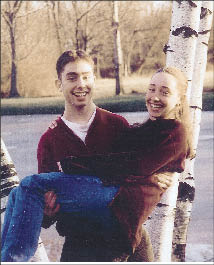 |
|
Alison and Brian: “His friends noticed changes in him,” but didn’t recognize the symptoms of mental illness. |
The sudden death of a young person often ignites a fire in mourning family members to do something about the social problem behind the tragedy, and Alison Malmon felt that fire after the suicide of her brother Brian in 2000. But Malmon didn’t launch a Brian’s Law or Brian’s Foundation; she created a nonprofit that helps her fellow collegians grapple with mental disorders – and that operated in virtual obscurity until last April.
Then a disturbed student shot to death 32 people at Virginia Tech.
Suddenly the news media were ringing the phone at Active Minds, which is no small matter: The nonprofit has just one phone, a black desktop thing with a cord that Malmon and her two staffers pass around an office that’s the size of a dorm room.
“It’s been an extremely busy month,” Malmon says as she takes a break at a nearby coffee shop to discuss her unplanned career as executive director of a nonprofit.
Active Minds strives to educate college students about mental illness and guide them toward help, primarily through its 65 campus chapters. Although it’s growing, Malmon has come to learn that her creation faces some specific challenges to its long-term survival: It’s a niche operation that doesn’t fit neatly into the funding plans of foundations, and she has to keep rebuilding her affiliates because from the moment the leaders join, they plan to leave.
To think, she could have been a flying trapeze artist at Club Med.
Filling a Gap
That’s one of the job opportunities the former gymnast says she had after graduating from the University of Pennsylvania in 2003. She was deciding what to do about a campus organization she had created in the wake of Brian’s death.
Brian was a high-functioning student at Columbia University who suffered from depression and psychosis, Malmon says. He left school, returned to the family home in the Washington suburb of Potomac, Md., and was in treatment when he shot himself.
Malmon, then a sophomore majoring in psychology and sociology, was subsequently struck by how her brother’s college pals knew nothing about his illness. “His friends noticed changes in him,” she says, but none recognized the symptoms of mental disorders.
She did some research and found a gap between the prevalence of mental health problems among college students and the lack of any significant effort to help educate students about those problems. So in 2001 she started a group at school called Open Minds, to get students talking about and recognizing signs of mental illness, and to refer them to resources. Then a former University of Pennsylvania student started a chapter at Georgetown University in Washington. More chapters gradually opened.
College graduation prompted Malmon to see if someone would adopt her organization so that she could move on. She says she spoke with the National Mental Health Association and the National Alliance on Mental Illness (NAMI), which opened its first campus chapter in 2002 and now has 30.
Malmon, however, felt that the focus of the groups was too different – NAMI focuses on severe mental disorders – and that Open Minds’ work would get lost within such large organizations that were not dedicated specifically to her target audience.
With seed money from an uncle who was a business entrepreneur in Miami, Malmon set out to launch her own nonprofit. Step One: Change the name. “Open Minds” was taken by a social services consulting firm based in Pennsylvania.
Her education? Her uncle gave her a one-hour walkthrough of “how to create a business plan,” she says. She read some books about running nonprofits “that weren’t very helpful.”
“I had a lot of adults telling me what to do,” she says.
Finding Leaders
At first Malmon ran Active Minds out of her Washington apartment, living off her savings and some family help. Her mother is a former social worker who worked in child welfare, and her father is an attorney.
The initial funding was “very personal,” she says – from family members, family friends and family foundations. It helps that hers is a low-overhead organization: Its fiscal 2003 tax returns show that it operated on $51,700 in contributions.
Today Active Minds subleases its tight space at cost in the offices of the National Association of Student Personnel Administrators. A photo of Brian hangs over Malmon’s computer. The building sits across the street from the Hilton Hotel where John Hinckley Jr. – whose mental illness showed but went untreated in college – shot President Reagan in 1981.
Building chapters is a slow process. Active Minds typically reaches out to students who come to its attention, often through campus newspaper stories about mental health.
Most chapters are run by students with mental illnesses or by psychology majors. Therein lies perhaps the biggest organizational challenge: The chapter leaders always move on from college, sometimes after just a year.
That’s one reason that at any given time, Malmon says, “five to 10 percent of our chapters are weak.” Yet a weak chapter one year becomes a strong one the next, thanks to new blood.
Another issue: “Many of our chapter leaders are not natural-born leaders,” she says. “It’s a whole new generation of leaders we’re empowering.”
The campus chapters hold meetings to discuss mental illness and its symptoms, conduct public education events on campus and refer youth to mental health services. The national office helps start new chapters, provides various forms of nonfinancial support to existing ones, convenes an annual national conference, produces a newsletter and spreads the word about mental health legislation and issues.
Helping to do that are Malmon’s two chapter coordinators. The nonprofit’s latest federal tax returns say that in fiscal 2005 it made contacts at more than 115 schools about starting chapters and developed 25 new ones. Malmon wants to have 300 chapters.
The Future
When the Virginia Tech shooting occurred, Malmon didn’t immediately see it as a big issue for Active Minds. The major concerns for mentally ill young people are hurting themselves or not getting help. The shooting, she says, “was not typical of a student dealing with a mental health disorder on campus.”
There is an Active Minds chapter at Virginia Tech – “not one of our strongest,” Malmon says. Shooter Seung-Hui Cho does not appear to have contacted it.
When news coverage shifted to Cho’s mental health problems, media outlets began calling Active Minds to talk about mental disorders and young people. Among those doing stories about Active Minds were The New York Times, CNN and Voice of America.
During the week of the shooting, activity on Active Minds’ website went up more than 300 percent, Malmon says. “Everybody was searching for an answer,” she says.
The extra attention brought a few more donations from individuals and one company, Malmon says.
Vincent Day is out to get more contributions. An Ohio-based consultant specializing in health care and higher education, Day was introduced to Malmon last fall through a mutual acquaintance. Seeing an earnest young woman who “didn’t have the experience of building a nonprofit,” Day offered to help by long distance. Now he’s chairman of the board.
The main financial challenge, Day says, is that “very few foundations are interested in funding mental health issues.” Another is that people believe colleges have enough money to fund such on-campus programs.
Malmon estimates that over the years she’s raised $150,000. Her first big foundation grant came last year, from the Ittleson Foundation in New York, for $85,000 over three years.
“We don’t have an aggressive fundraising plan, but we’re going to put one in place,” Day says.
Contact: (202) 719-1177, http://www.activemindsoncampus.org.






























